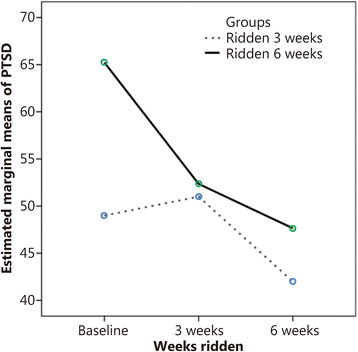Effects of therapeutic horseback riding on post-traumatic stress disorder in military veterans
- PMID: 29502529
- PMCID: PMC5774121
- DOI: 10.1186/s40779-018-0149-6
Effects of therapeutic horseback riding on post-traumatic stress disorder in military veterans
Abstract
Background: Large numbers of post-deployment U.S. veterans are diagnosed with post-traumatic stress disorder (PTSD) and/or traumatic brain injury (TBI), leading to an urgent need for effective interventions to reduce symptoms and increase veterans' coping. PTSD includes anxiety, flashbacks, and emotional numbing. The symptoms increase health care costs for stress-related illnesses and can make veterans' civilian life difficult.
Methods: We used a randomized wait-list controlled design with repeated measures of U.S. military veterans to address our specific aim to test the efficacy of a 6-week therapeutic horseback riding (THR) program for decreasing PTSD symptoms and increasing coping self-efficacy, emotion regulation, social and emotional loneliness. Fifty-seven participants were recruited and 29 enrolled in the randomized trial. They were randomly assigned to either the horse riding group (n = 15) or a wait-list control group (n = 14). The wait-list control group experienced a 6-week waiting period, while the horse riding group began THR. The wait-list control group began riding after 6 weeks of participating in the control group. Demographic and health history information was obtained from all the participants. PTSD symptoms were measured using the standardized PTSD Checklist-Military Version (PCL-M). The PCL-M as well as other instruments including, The Coping Self Efficacy Scale (CSES), The Difficulties in Emotion Regulation Scale (DERS) and The Social and Emotional Loneliness Scale for Adults-short version (SELSA) were used to access different aspects of individual well-being and the PTSD symptoms.
Results: Participants had a statistically significant decrease in PTSD scores after 3 weeks of THR (P ≤ 0.01) as well as a statistically and clinically significant decrease after 6 weeks of THR (P ≤ 0.01). Logistic regression showed that participants had a 66.7% likelihood of having lower PTSD scores at 3 weeks and 87.5% likelihood at 6 weeks. Under the generalized linear model(GLM), our ANOVA findings for the coping self-efficacy, emotion regulation, and social and emotional loneliness did not reach statistical significance. The results for coping self-efficacy and emotion regulation trended in the predicted direction. Results for emotional loneliness were opposite the predicted direction. Logistic regression provided validation that outcome effects were caused by riding longer.
Conclusion: The findings suggest that THR may be a clinically effective intervention for alleviating PTSD symptoms in military veterans.
Keywords: Animal-assisted intervention; Coping self-efficacy; Emotion regulation; Military veterans; Post-traumatic stress disorder; Social engagement; Therapeutic horseback riding; Traumatic brain injury.
Conflict of interest statement
Ethics approval and consent to participate
This material is the result of work supported with resources and the use of facilities at the Harry S. Truman Memorial Veterans Hospital, Columbia, MO. The study had the approval of the VA Research and Development Committee at the Harry S. Truman Memorial Veterans Hospital, the University of Missouri Health Sciences Institutional Review Board (#1207664), and the university’s Animal Care and Use Committee (#7760). All participants completed the VA Research Consent Form, which had HS IRB approval. The HS IRB is the IRB of record for the Harry S. Truman Memorial Veterans Hospital.
Competing interests
The authors declare that they have no competing interests.
Figures


Similar articles
-
Efficacy of equine-assisted psychotherapy in veterans with posttraumatic stress disorder.J Integr Med. 2019 Jan;17(1):14-19. doi: 10.1016/j.joim.2018.11.001. Epub 2018 Nov 16. J Integr Med. 2019. PMID: 30497951 Clinical Trial.
-
Experiences of Military Veterans in a Therapeutic Horseback Riding Program.Clin Nurs Res. 2021 Sep;30(7):923-933. doi: 10.1177/10547738211003580. Epub 2021 Apr 15. Clin Nurs Res. 2021. PMID: 33855883 Clinical Trial.
-
Completion of a Veteran-Focused Civic Service Program Improves Health and Psychosocial Outcomes in Iraq and Afghanistan Veterans With a History of Traumatic Brain Injury.Mil Med. 2017 Jul;182(7):e1763-e1770. doi: 10.7205/MILMED-D-16-00150. Mil Med. 2017. PMID: 28810970 Free PMC article.
-
The Transcendental Meditation Program's Impact on the Symptoms of Post-traumatic Stress Disorder of Veterans: An Uncontrolled Pilot Study.Mil Med. 2018 Jan 1;183(1-2):e144-e150. doi: 10.1093/milmed/usx059. Mil Med. 2018. PMID: 29401353
-
The incorporation of emotion-regulation skills into couple- and family-based treatments for post-traumatic stress disorder.Mil Med Res. 2017 Jun 30;4:21. doi: 10.1186/s40779-017-0130-9. eCollection 2017. Mil Med Res. 2017. PMID: 28680693 Free PMC article. Review.
Cited by 11 articles
-
Measuring Equine-Assisted Therapy: Validation and Confirmatory Factor Analysis of an ICF-Based Standardized Assessment-Tool.Int J Environ Res Public Health. 2022 Feb 26;19(5):2738. doi: 10.3390/ijerph19052738. Int J Environ Res Public Health. 2022. PMID: 35270430 Free PMC article.
-
Transition from military to civilian: Identity, social connectedness, and veteran wellbeing.PLoS One. 2021 Dec 22;16(12):e0261634. doi: 10.1371/journal.pone.0261634. eCollection 2021. PLoS One. 2021. PMID: 34936679 Free PMC article.
-
Effectiveness of animal-assisted interventions for children and adults with post-traumatic stress disorder symptoms: a systematic review and meta-analysis.Eur J Psychotraumatol. 2021 Mar 23;12(1):1879713. doi: 10.1080/20008198.2021.1879713. eCollection 2021. Eur J Psychotraumatol. 2021. PMID: 34377357 Free PMC article. Review.
-
Equine-Assisted Interventions (EAIs) for Children with Autism Spectrum Disorders (ASD): Behavioural and Physiological Indices of Stress in Domestic Horses (Equus caballus) during Riding Sessions.Animals (Basel). 2021 May 27;11(6):1562. doi: 10.3390/ani11061562. Animals (Basel). 2021. PMID: 34071859 Free PMC article.
-
Equine-Assisted Activities and Therapies for Veterans With Posttraumatic Stress Disorder: Current State, Challenges and Future Directions.Chronic Stress (Thousand Oaks). 2021 Feb 15;5:2470547021991556. doi: 10.1177/2470547021991556. eCollection 2021 Jan-Dec. Chronic Stress (Thousand Oaks). 2021. PMID: 33644617 Free PMC article. Review.
References
-
- Meregillano G. Hippotherapy. Phys Med Rehabil Clin N Am. 2004;15:843–54. 10.1016/j.pmr.2004.02.002. - PubMed
-
- Silkwood-Sherer D. The difference lies in the perspective. NARHA’s Stride. 2003;9:14–16.
-
- Bandura A. Social foundations of thought and action: a social cognitive theory. Englewood Cliffs, NJ: Prentice-Hall; 1986.
-
- U.S. Dept. of Veterans Affairs, National Center for PTSD. PTSD History and Overview. 2015. http://www.ptsd.va.gov/professional/PTSD-overview/ptsd-overview.asp. Accessed 18 Oct 2017.
-
- U.S. Census Bureau. Veterans – the 2012 statistical abstract. 2012. https://www.ptsd.va.gov/public/ptsd-overview/basics/how-common-is-ptsd.asp. Accessed 18 Oct 2017.
Publication types
MeSH terms
Grant support
LinkOut - more resources
Full Text Sources
Other Literature Sources
Medical

